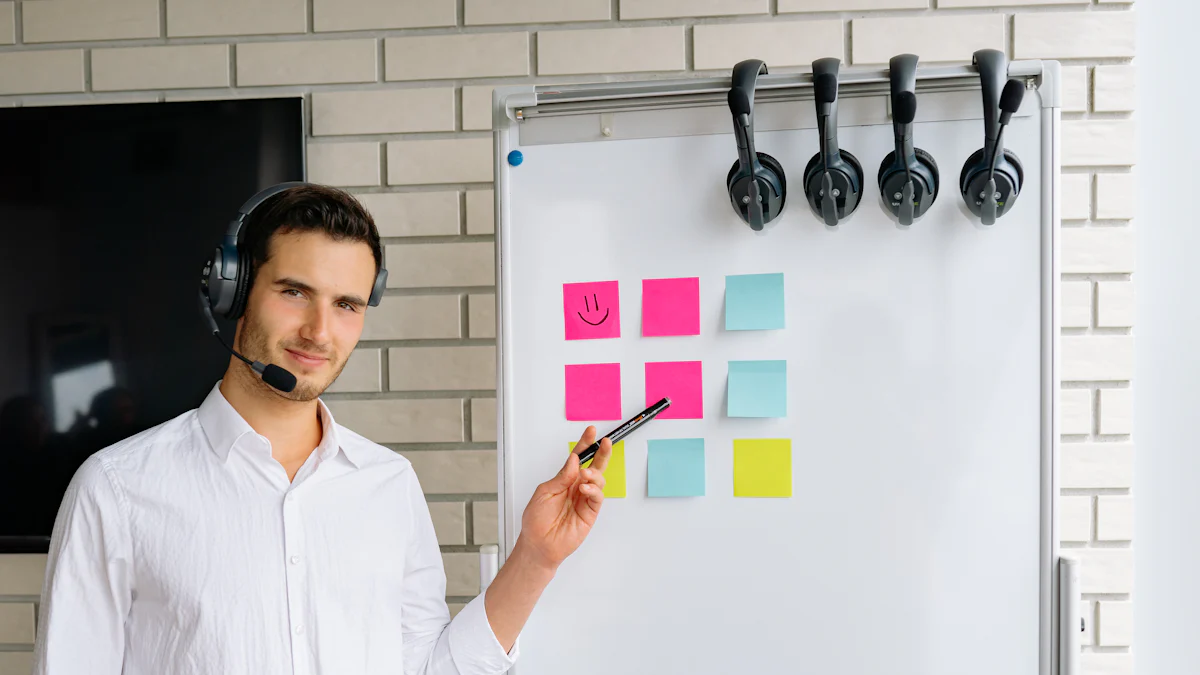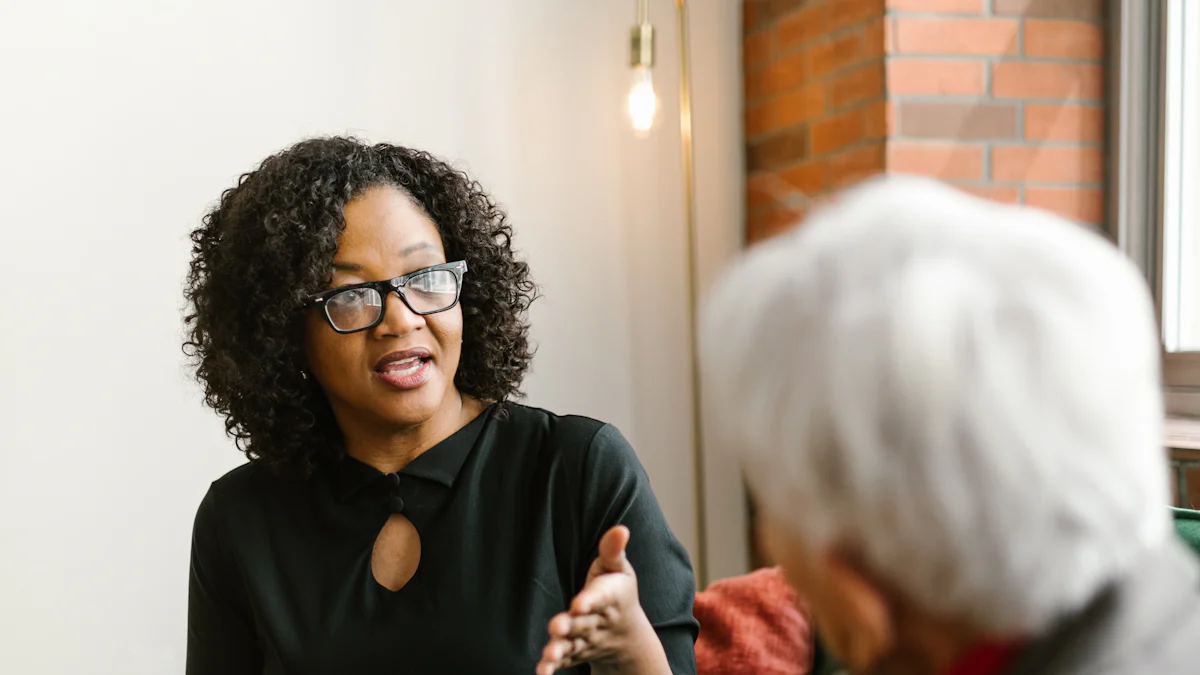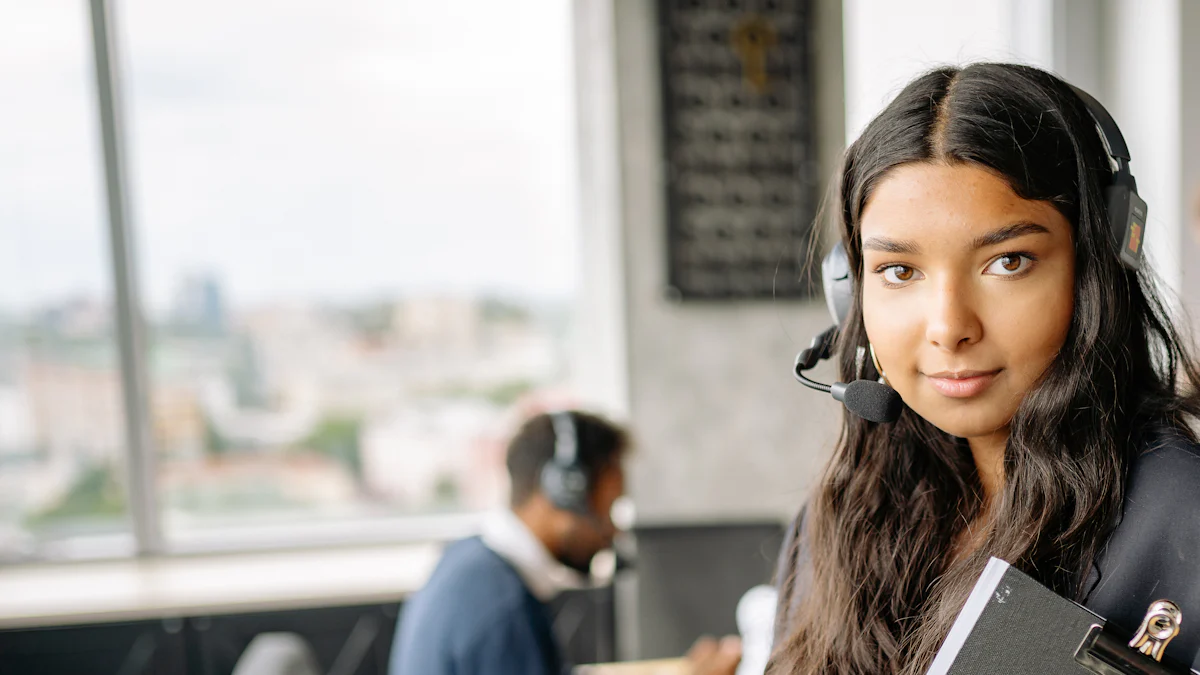How to Succeed in Mock Interviews as a Nonverbal Individual
Try Aihirely for
Smarter Interview Prep
Experience real-time AI support tailored to your Resume.
Boost your confidence and ace every question with
AI Mock Interview.

Image Source: pexels
Mock interviews can feel intimidating, especially if you’re a nonverbal individual. You might wonder how to convey confidence or connect with interviewers without speaking. These challenges are common, but they’re not insurmountable. Mock interviews offer a safe space to practice and refine your communication skills. They help you identify areas for improvement, like body language or attentiveness, and develop strategies to overcome obstacles. Studies show that practicing in mock interviews reduces anxiety and builds self-assurance. By learning how to do mock interviews as a non verbal person, you can boost your confidence and ace real interviews.
Key Takeaways
-
Body language is important in interviews. Stand tall, make eye contact, and smile to show interest and confidence.
-
Use tools like text-to-speech devices to practice. These tools help you share your ideas clearly and with confidence.
-
Practice interviews with friends or mentors. This helps you understand how interviews work and feel less nervous.
-
Record your practice interviews and watch them later. This helps you see what you can do better and track your growth.
-
Celebrate small successes during practice. Noticing your progress makes you feel good and keeps you motivated.
The Importance of Nonverbal Communication in Interviews

Image Source: pexels
Why Nonverbal Communication is Key
Conveying confidence through body language
Your body language speaks volumes, even when you don’t say a word. A confident posture, steady breathing, and controlled movements can make you appear calm and self-assured. For example, standing tall or sitting upright shows you’re attentive and ready to engage. Avoid fidgeting, as it might suggest nervousness or a lack of focus. Instead, keep your movements deliberate and composed to project confidence.
Using facial expressions to show engagement
Your face can express what words cannot. A genuine smile can create a warm connection with your interviewer, while nodding occasionally shows you’re actively listening. Maintaining a calm and open expression demonstrates that you’re composed under pressure. Strong eye contact is especially powerful—it signals interest and credibility. For instance, candidates like Mark, who maintained consistent eye contact, left a lasting impression of confidence and attentiveness.
Essential Nonverbal Cues to Master
Posture and sitting position
How you sit during an interview matters. Sitting upright with your shoulders back conveys professionalism and focus. Slouching, on the other hand, might suggest disinterest. Sarah, for example, impressed her interviewer with her excellent posture, which reflected her seriousness about the role. Practice sitting in a way that feels natural yet professional to ensure you’re sending the right message.
Eye contact and attentiveness
Eye contact is one of the most important nonverbal cues. It shows you’re engaged and confident. Avoid staring, but aim to maintain steady eye contact throughout the conversation. This simple act can help you build rapport with your interviewer. If you’re using assistive tools, like text-to-speech devices, you can still glance up occasionally to show attentiveness.
Hand gestures and their role in communication
Your hands can emphasize your points and make your communication more dynamic. Controlled gestures, like open palms, can make you appear approachable and honest. Avoid crossing your arms or fidgeting, as these can signal nervousness. Candidates like Michael, who managed his hand movements effectively, projected confidence despite feeling nervous. Practicing gestures during mock interviews can help you refine this skill.
Tip: Nonverbal communication plays a huge role in forming first impressions. A warm smile, good posture, and steady eye contact can set a positive tone for the entire interview.
By mastering these nonverbal cues, you’ll not only improve your mock interview performance but also feel more prepared for real-life scenarios. Learning how to do mock interviews as a non verbal person involves focusing on these subtle yet impactful details.
How to Do Mock Interviews as a Non Verbal Person
Leveraging Assistive Tools and Technology
Using text-to-speech or communication devices
Technology can be your best ally during mock interviews. Text-to-speech devices or communication apps allow you to express your thoughts clearly and effectively. These tools help you craft responses in advance, so you can focus on delivering them confidently. For instance, you can prepare answers to common questions and use your device to share them during the interview. This approach ensures your responses are concise and well-structured.
If you’re new to these tools, practice using them in casual conversations first. Familiarity with the device will make you more comfortable during the interview. Remember, the goal is to let your skills and personality shine through, even if you’re communicating differently.
Practicing with AI-based mock interview platforms
AI-based platforms offer a safe and judgment-free space to practice. These tools simulate real interview scenarios, giving you a chance to refine your responses and nonverbal cues. Some platforms even provide feedback on your performance, helping you identify areas for improvement. For example, they might highlight if your posture needs adjustment or if your responses could be more concise.
Using these platforms regularly can boost your confidence. They allow you to experiment with different strategies and find what works best for you. Plus, practicing in a virtual setting prepares you for online interviews, which are increasingly common.
Practicing with Partners or Mentors
Simulating realistic interview scenarios
Working with a partner or mentor can make a big difference. They can help you simulate real interview settings, complete with introductions, questions, and follow-ups. This practice helps you get used to the flow of an interview and reduces the element of surprise.
During these sessions, focus on key nonverbal cues like posture, eye contact, and gestures. Here’s a quick look at how these elements can enhance your performance:
| Benefit | Description |
|---|---|
| Practice good posture | Helps project professionalism and confidence. |
| Maintain eye contact | Indicates engagement and genuine interest. |
| Use appropriate gestures | Enhances communication without distracting fidgeting. |
Recording sessions for self-review and feedback
Recording your mock interviews is a game-changer. Watching the playback allows you to spot areas for improvement, like slouching or avoiding eye contact. It also helps you track your progress over time.
Ask your partner or mentor for feedback after each session. Their insights can guide you in refining your nonverbal communication. Over time, you’ll notice improvements in your confidence and overall performance.
Tip: Celebrate small wins during practice. Each step forward builds your confidence for the real thing.
Preparing for Common Interview Questions
Crafting concise written responses
Preparing written answers to common questions is essential. Focus on clarity and brevity. For example, instead of listing every detail about your experience, highlight the most relevant points. This approach keeps your responses engaging and easy to follow.
Start by researching typical interview questions for your field. Then, write down your answers and practice delivering them using your assistive tools. This preparation ensures you’re ready to tackle any question with confidence.
Tailoring answers to specific roles or industries
Generic answers won’t make you stand out. Tailor your responses to align with the job or industry you’re targeting. For instance, if you’re applying for a tech role, emphasize your problem-solving skills and technical expertise.
Research the company and role beforehand. Use this information to craft responses that show you’re a perfect fit. Tailored answers demonstrate your genuine interest and make a lasting impression.
Note: Knowing how to do mock interviews as a non verbal person involves preparation, practice, and personalization. These steps help you showcase your strengths effectively.
Crafting a Strong Self-Introduction and Responses
Structuring Your Self-Introduction
Highlighting key skills and experiences
Your self-introduction sets the tone for the interview. It’s your chance to showcase your skills and experiences that make you the perfect fit for the role. Start by briefly mentioning your background, like your education or work experience. Then, highlight your top skills. For example, if you’re applying for a design role, you might say, “I have three years of experience in graphic design, specializing in creating user-friendly interfaces.”
Keep your introduction concise and focused. Avoid overwhelming the interviewer with too much detail. Instead, emphasize the qualities that align with the job. Practicing this introduction during mock interviews will help you refine it and deliver it confidently.
Using nonverbal cues to enhance your introduction
Nonverbal cues can make your introduction even more impactful. A firm handshake, for instance, conveys confidence and professionalism. Maintaining eye contact shows you’re attentive and self-assured. Good posture signals readiness, while a warm smile creates a friendly connection.
Here’s how you can use these cues effectively:
-
A firm handshake leaves a strong first impression.
-
Eye contact shows confidence and attentiveness.
-
Upright posture signals professionalism.
-
A genuine smile conveys enthusiasm.
-
Nodding occasionally shows you’re actively engaged.
For example, Jane’s firm handshake and Sarah’s upright posture impressed their interviewers. Similarly, Chris’s warm smile made him approachable. These small actions can make a big difference in how you’re perceived.
Answering Questions with Confidence
Combining written responses with gestures or visuals
When answering questions, combine your written responses with gestures or visuals to make your points clear. For instance, if you’re discussing a project, you could use a chart or diagram to illustrate your achievements. Gestures like open palms can emphasize honesty and openness.
If you’re using assistive tools, practice syncing your gestures with your device’s output. This coordination makes your communication feel natural and engaging. Mock interviews are a great way to practice this skill.
Demonstrating problem-solving skills through examples
Employers love candidates who can solve problems. Use specific examples to show your problem-solving abilities. For instance, you might say, “In my previous role, I streamlined a process that saved the team 10 hours a week.”
Pair these examples with confident nonverbal cues. A calm expression and steady eye contact reinforce your credibility. If you’re using visuals, like a portfolio or presentation, make sure they’re clear and professional.
By combining preparation, nonverbal communication, and examples, you’ll answer questions with confidence and leave a lasting impression. Learning how to do mock interviews as a non verbal person helps you master these techniques and showcase your strengths effectively.
Building Confidence and Managing Nerves

Image Source: pexels
Staying Calm During Interviews
Breathing exercises to reduce anxiety
Feeling nervous before or during an interview? Breathing exercises can help you stay calm and focused. Here are a few techniques you can try:
-
Deep Breathing: Slowly inhale through your nose, filling your lungs and abdomen, then exhale fully through your mouth. This relaxes your body and clears your mind.
-
Rhythmic Breathing: Breathe in for four counts and out for four counts. This steady rhythm helps you stay composed.
-
Mindful Breathing: Pay attention to your breath without judgment. This keeps you grounded and reduces stress.
-
Box Breathing: Inhale for four seconds, hold your breath for four seconds, exhale for four seconds, and hold again for four seconds. This technique is great for calming nerves in high-pressure moments.
Practicing these exercises regularly can make a big difference. They’re simple, quick, and effective tools to manage anxiety.
Visualization techniques to prepare mentally
Visualization is another powerful way to prepare for interviews. Picture yourself in the interview room. Imagine sitting confidently, maintaining eye contact, and using gestures to express yourself. This mental rehearsal helps you practice nonverbal communication and reduces the fear of the unknown.
You can also visualize how you’d handle tough questions. Think about your responses and how you’d present them. This preparation makes you feel more in control and ready for any surprises. Visualization isn’t just about imagining success—it’s about building the confidence to achieve it.
Gaining Confidence Through Practice
Celebrating small wins and progress
Confidence grows with every small victory. Celebrate moments like making eye contact, using a new word, or completing a mock interview without hesitation. These achievements may seem minor, but they’re stepping stones to bigger successes.
Acknowledging your progress boosts your emotional well-being. It also creates a positive mindset that motivates you to keep improving. Even small wins deserve recognition because they show how far you’ve come.
Learning from feedback and improving over time
Feedback is your best friend when it comes to growth. After each mock interview, take time to reflect on what went well and what could improve. Here’s how you can use feedback effectively:
| Strategy | Implementation | Benefit |
|---|---|---|
| Regular self-assessment | Record and review your mock interviews | Identifies areas needing improvement |
| Feedback journal | Write down feedback after each session | Tracks progress and reveals patterns |
| Skill benchmarking | Compare your performance to industry standards | Helps focus on key development areas |
Constructive criticism isn’t something to fear. It’s an opportunity to grow. Use it to set realistic goals and track your progress over time. With each improvement, your confidence will soar, and you’ll feel more prepared for real interviews.
Tip: Confidence doesn’t happen overnight. Celebrate your journey, learn from every experience, and trust in your ability to succeed.
Following Up and Continuous Improvement
Effective Follow-Up Strategies
Sending a thank-you note after the interview
A thank-you note might seem like a small gesture, but it can leave a big impression. It shows professionalism and gratitude, which interviewers appreciate. Here’s how to craft a standout thank-you note:
-
Send it promptly—ideally within 30 minutes to 2 hours after the interview.
-
Personalize it by mentioning specific points from your conversation. For example, reference a project or topic you discussed.
-
Avoid generic templates. Instead, let your personality shine through.
Recruiters often remember candidates who take the time to send a thoughtful thank-you email. It’s a simple way to stand out and reinforce your interest in the role.
Reiterating your interest in the role
Your thank-you note is also a chance to reiterate your enthusiasm for the position. Mention why you’re excited about the opportunity and how your skills align with the company’s goals. For example, you could say, “I’m thrilled about the chance to contribute to your team’s innovative projects.”
This follow-up not only keeps you on the interviewer’s radar but also reinforces your commitment to the role. A little effort here can go a long way in making a lasting impression.
Using Feedback to Grow
Identifying areas for improvement
Feedback from mock interviews is a goldmine for growth. It helps you pinpoint areas that need work, whether it’s your body language, communication style, or preparation. Common areas for improvement include:
-
Skill development: Focus on specific competencies, like problem-solving or technical expertise.
-
Behavioral changes: Address habits like fidgeting or avoiding eye contact.
-
Practice and preparation: Dedicate time to refining your responses and nonverbal cues.
By identifying these areas, you can create a clear roadmap for improvement. Each step you take brings you closer to mastering your interview skills.
Setting goals for future mock interviews
Setting actionable goals is key to continuous improvement. Start by recording your mock interviews to spot patterns and areas for growth. Then, ask your mock interviewer for specific feedback on your nonverbal communication.
Here are some practical goals you can set:
-
Improve posture and maintain steady eye contact.
-
Practice syncing gestures with your responses.
-
Enhance your confidence by rehearsing in front of a mirror or with a friend.
Breaking these goals into smaller, manageable steps makes them easier to achieve. Over time, you’ll notice significant progress in your performance.
Tip: Treat each mock interview as a learning experience. The more you practice, the more confident and prepared you’ll feel for the real thing.
Success in mock interviews is absolutely within your reach. With preparation and practice, you can overcome challenges and showcase your unique strengths. Remember, your communication style is a part of who you are—embrace it confidently.
Tip: Focus on what makes you stand out. Your skills, determination, and effort matter more than anything else.
Keep practicing, learning, and improving. Each step forward brings you closer to your goals. Stay persistent, and don’t forget to celebrate your progress along the way. You’ve got this!
FAQ
1. How can I make a strong first impression without speaking?
Focus on your nonverbal cues. Sit upright, maintain eye contact, and smile warmly. Use a firm handshake if appropriate. These actions show confidence and professionalism. Practice these gestures during mock interviews to make them feel natural.
2. What if I forget my prepared responses during the interview?
Stay calm and take a moment to gather your thoughts. Use your assistive device to refer to your notes. Pausing briefly shows composure. Practicing frequently will help you feel more prepared and reduce the chances of forgetting.
3. Can I still connect with the interviewer if I’m nonverbal?
Absolutely! Use eye contact, nodding, and facial expressions to show engagement. A genuine smile can create a positive connection. Your body language and thoughtful responses will help you build rapport effectively.
4. How do I handle unexpected questions?
Prepare for this by practicing flexibility. If you don’t have an immediate answer, use your device to type a thoughtful response. You can also acknowledge the question and ask for a moment to think. Staying composed is key.
5. Are mock interviews really necessary for nonverbal individuals?
Yes! Mock interviews help you refine your nonverbal communication and get comfortable with assistive tools. They also build your confidence. Treat them as a safe space to practice and improve. Each session prepares you better for real interviews.
Tip: Practice makes progress. The more you rehearse, the more confident you’ll feel in any interview setting.
